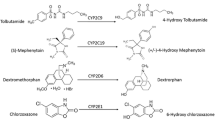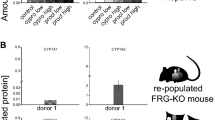Abstract
Species difference in the induction of hepatic cytochrome P450 CYP1A subfamily enzymes by 2-methoxy-4-nitroaniline (2-MeO-4-NA) was investigated among male F344 rats, C57BL/6 Cr mice, and Hartley guinea pigs. All species of animals were treated with a single ip injection of 2-MeO-4-NA (0.44 mmol/kg body weight), and changes in levels of the mRNA and protein of hepatic cytochrome P4501A (CYP1A) subfamily enzymes were examined by the methods of RT-PCR and Western blot, respectively. In addition, hepatic microsomal enzyme activities were measured using methoxyresorufin and ethoxyresorufin as substrates of CYP1A2 and CYP1A1, respectively. The overall results of the RT-PCR, Western blot, and measurement of the enzyme activity indicated that 2-MeO-4-NA-mediated induction of hepatic CYP1A subfamily enzymes, especially CYP1A2, occurred only in rats but not any other species of animals examined and that the species difference in the CYP1A induction was not necessarily correlated with that in pharmacokinetics of 2-MeO-4-NA. Furthermore, a luciferase reporter gene assay for screening of the ligands of arylhydrocarbon receptor (AhR) using a rat hepatic cell line suggested that 2-MeO-4-NA is not an AhR ligand. The present findings demonstrate for the first time the species difference in the 2-MeO-4-NA-mediated induction of hepatic CYP1A subfamily enzymes between rats and other rodents, mice and guinea pigs, and further propose an AhR-independent pathway for 2-MeO-4-NA-mediated induction in rats.






Similar content being viewed by others
References
Burke MD, Thompson S, Elcombe CR, Halpert J, Haaparanta T, Mayer RT (1985) Ethoxy-, pentoxy- and benzyloxyphenoxazones and homologues: a series of substrates to distinguish between different induced cytochromes P-450. Biochem Pharmacol 34:3337–3345
Burke MD, Thompson S, Weaver RJ, Wolf CR, Mayer RT (1994) Cytochrome P450 specificities of alkoxyresorufin O-dealkylation in human and rat liver. Biochem Pharmacol 48:923–936
Chaloupka K, Santostefano M, Goldfarb IS, Liu G, Myers MJ, Tsyrolv IB, Gelboin HV, Krishnan V, Safe S (1994) Aryl hydrocarbon (Ah) receptor-independent induction of Cyp1a2 gene expression by acenaphthylene and related compounds in B6C3F1 mice. Carcinogenesis 15:2835–2840
Cheung YL, Puddicombe SM, Gray TJ, Ioannides C (1994) Mutagenicity and CYP1A induction by azobenzenes correlates with their carcinogenicity. Carcinogenesis 15:1257–1263
Conney AH (1982) Induction of microsomal enzymes by foreign chemicals and carcinogenesis by polycyclic aromatic hydrocarbons: G. H. A. Clowes memorial lecture. Cancer Res 42:4875–4917
Corcos L, Marc N, Wein S, Fautrel A, Guillouzo A, Pineau T (1998) Phenobarbital induces cytochrome P4501A2 hnRNA, mRNA and protein in the liver of C57BL/6J wild type and aryl hydrocarbon receptor knock-out mice. FEBS Lett 425:293–297
Degawa M, Kojima M, Hashimoto Y (1984) Species difference between rats and mice in activities of enzymes activating aromatic amines: effect of dietary 3-methoxy-4-aminoazobenzene. Gann 75:966–975
Degawa M, Kojima M, Hishinuma T, Hashimoto Y (1985) Sex-dependent induction of hepatic enzymes for mutagenic activation of a tryptophan pyrolysate component, 3-amino-1,4-dimethyl-5H-pyrido[4,3-b]-indole, by feeding in mice. Cancer Res 45:96–102
Degawa M, Kojima M, Sato Y, Hashimoto Y (1986) Induction of a high spin form of microsomal cytochrome P-448 in rat liver by 4-aminoazobenzene derivatives. Biochem Pharmacol 35:3565–3570
Degawa M, Hishinuma T, Yoshida H, Hashimoto Y (1987) Species, sex and organ differences in induction of a cytochrome P-450 isozyme responsible for carcinogen activation: effects of dietary hepatocarcinogenic tryptophan pyrolysate components in mice and rats. Carcinogenesis 8:1913–1918
Degawa M, Yamaya C, Hashimoto Y (1988) Hepatic cytochrome P-450 isozyme(s) induced by dietary carcinogenic aromatic amines preferentially in female mice of DBA/2 and other strains. Carcinogenesis 9:567–571
Degawa M, Tanimura S, Agatsuma T, HashimotoY (1989) Hepatocarcinogenic heterocyclic aromatic amines that induce cytochrome P-448 isozymes, mainly cytochrome P-448H (P-450 IA2), responsible for mutagenic activation of the carcinogens in rat liver. Carcinogenesis 10:1119–1122
Degawa M, Nakayama M, Yoshinari K, Hashimoto Y (1995) 2-Methoxy-4-nitroaniline is a selective inducer of cytochrome P450IA2 (CYP1A2) in rat liver. Cancer Lett 96:95–98
Degawa M, Nakayama M, Konno Y, Masubuchi K, Yamazoe Y (1998) 2-Methoxy-4-nitroaniline and its isomers induce cytochrome P4501A (CYP1A) enzymes with different selectivities in the rat liver. Biochim Biophys Acta 1379:391–398
Degawa M, Namiki M, Yoshimoto N, Makino M, Iwamoto M, Nemoto K, Hashimoto Y (2003) Constitutive expression of cytochrome p450 genes in newly established rat hepatic cell lines. J Biochem (Tokyo) 133:825–831
Fung VA, Huff J, Weisburger EK, Hoel DG (1993) Predictive strategies for selecting 379 NCI/NTP chemicals evaluated for carcinogenic potential: scientific and public health impact. Fundam Appl Toxicol 20:413–436
Gomez-Lechon MJ, Jover R, Donato T, Ponsoda X, Rodriguez C, Stenzel KG, Klocke R, Paul D, Guillen I, Bort R, Castell JV (1998) Long-term expression of differentiated functions in hepatocytes cultured in three-dimensional collagen matrix. J Cell Physiol 177:553–562
Ishii K, Yamazoe Y, Kamataki T, Kato R (1981) Metabolic activation of glutamic acid pyrolysis products, 2-amino-6-methyldipyrido[1,2-a:3′,2′-d]imidazole and 2-amino-dipyrido[1,2-a:3′,2′-d]imidazole, by purified cytochrome P-450. Chem Biol Interact 38:1–13
Kamataki T, Maeda K, Yamazoe Y, Matsuda N, Ishii K, Kato R (1983) A high-spin form of cytochrome P-450 highly purified from polychlorinated biphenyl-treated rats. Catalytic characterization and immunochemical quantitation in liver microsomes. Mol Pharmacol 24:146–155
Kim SG, Reddy SL, States JC, Novak RF (1991) Pyridine effects on expression and molecular regulation of the cytochrome P450IA gene subfamily. Mol Pharmacol 40:52–57
Kleman M, Övervik E, Mason G, Gustafsson JÅ (1990) Effects of the food mutagens MeIQx and PhIP on the expression of cytochrome P450IA proteins in various tissues of male and female rats. Carcinogenesis 11:2185–2189
Lowry OH, Rosebrough NJ, Farr AL, Randall RJ (1951) Protein measurement with the Folin phenol reagent. J Biol Chem 193:265–275
Mathur NK, Mathur A, Banerjee K (1985) Contact dermatitis in tie and dye industry workers. Contact Derm 12:38–41
Miller MS, Jones AB, Park SS, Anderson LM (1990) The formation of 3-methylcholanthrene-initiated lung tumors correlates with induction of cytochrome P450IA1 by the carcinogen in fetal but not adult mice. Toxicol Appl Pharmacol 104:235–245
Mimura J, Fujii-Kuriyama Y (2003) Functional role of AhR in the expression of toxic effects by TCDD. Biochim Biophys Acta 1619:263–268
Nebert DW, Jones JE (1989) Regulation of the mammalian cytochrome P1–450 (CYP1A1) gene. Int J Biochem 21:243–252
Nebert DW, Robinson JR, Niwa A, Kumaki K, Poland AP (1975) Genetic expression of aryl hydrocarbon hydroxylase activity in the mouse. J Cell Physiol 85:393–414
Niwa A, Kumaki K, Nebert DW, Poland AP (1975) Genetic expression of aryl hydrocarbon hydroxylase activity in the mouse. Distinction between the “responsive” homozygote and heterozygote at the Ah locus. Arch Biochem Biophys 166:559–564
Quattrochi LC, Vu T, Tukey RH (1994) The human CYP1A2 gene and induction by 3-methylcholanthrene. A region of DNA that supports AH-receptor binding and promoter-specific induction. J Biol Chem 269:6949–6954
Ryu DY, Levi PE, Fernandez-Salguero P, Gonzalez FJ, Hodgson E (1996) Piperonyl butoxide and acenaphthylene induce cytochrome P450 1A2 and 1B1 mRNA in aromatic hydrocarbon-responsive receptor knock-out mouse liver. Mol Pharmacol 50:443–446
Sekimoto M, Iwamoto M, Miyajima S, Nemoto K, Degawa M (2004) Establishment of a rat hepatic cell line, KanR2-XL8, for a reporter gene assay of aryl hydrocarbon receptor ligands. J Health Sci 50:530–536
Seree EM, Villard PH, Re JL, De Meo M, Lacarelle B, Attolini L, Dumenil G, Catalin J, Durand A, Barra Y (1996) High inducibility of mouse renal CYP2E1 gene by tobacco smoke and its possible effect on DNA single strand breaks. Biochem Biophys Res Commun 219:429–434
Shimizu Y, Nakatsuru Y, Ichinose M, Takahashi Y, Kume H, Mimura J, Fujii-Kuriyama Y, Ishikawa T (2000) Benzo[a]pyrene carcinogenicity is lost in mice lacking the aryl hydrocarbon receptor. Proc Natl Acad Sci USA 97:779–782
Silver G, Krauter KS (1988) Expression of cytochromes P-450c and P-450d mRNAs in cultured rat hepatocytes. 3-Methylcholanthrene induction is regulated primarily at the post-transcriptional level. J Biol Chem 263:11802–11807
Sogawa K, Numayama-Tsuruta K, Takahashi T, Matsushita N, Miura C, Nikawa J, Gotoh O, Kikuchi Y, Fujii-Kuriyama Y (2004) A novel induction mechanism of the rat CYP1A2 gene mediated by Ah receptor-Arnt heterodimer. Biochem Biophys Res Commun 318:746–755
Whitlock JP Jr (1999) Induction of cytochrome P4501A1. Annu Rev Pharmacol Toxicol 39:103–125
Wool IG, Chan YL, Paz V, Olvera J (1990) The primary structure of rat ribosomal proteins: the amino acid sequences of L27a and L28 and corrections in the sequences of S4 and S12. Biochim Biophys Acta 1050:69–73
Acknowledgments
This work was supported in part by a Grant-in-Aid for Scientific Research from the Japan Society for the Promotion of Science (M.D.). The authors thank Mr. Masaru Tsutsui and Mr. Tetsuaki Takahashi of Kissei Pharmaceutical Co. Ltd. for pharmacokinetic evaluation and technical support. All the experiments complied with the current laws of Japan.
Author information
Authors and Affiliations
Corresponding author
Rights and permissions
About this article
Cite this article
Souma, S., Sekimoto, M. & Degawa, M. Species difference in the induction of hepatic CYP1A subfamily enzymes, especially CYP1A2, by 2-methoxy-4-nitroaniline among rats, mice, and guinea pigs. Arch Toxicol 80, 739–747 (2006). https://doi.org/10.1007/s00204-006-0103-3
Received:
Accepted:
Published:
Issue Date:
DOI: https://doi.org/10.1007/s00204-006-0103-3




